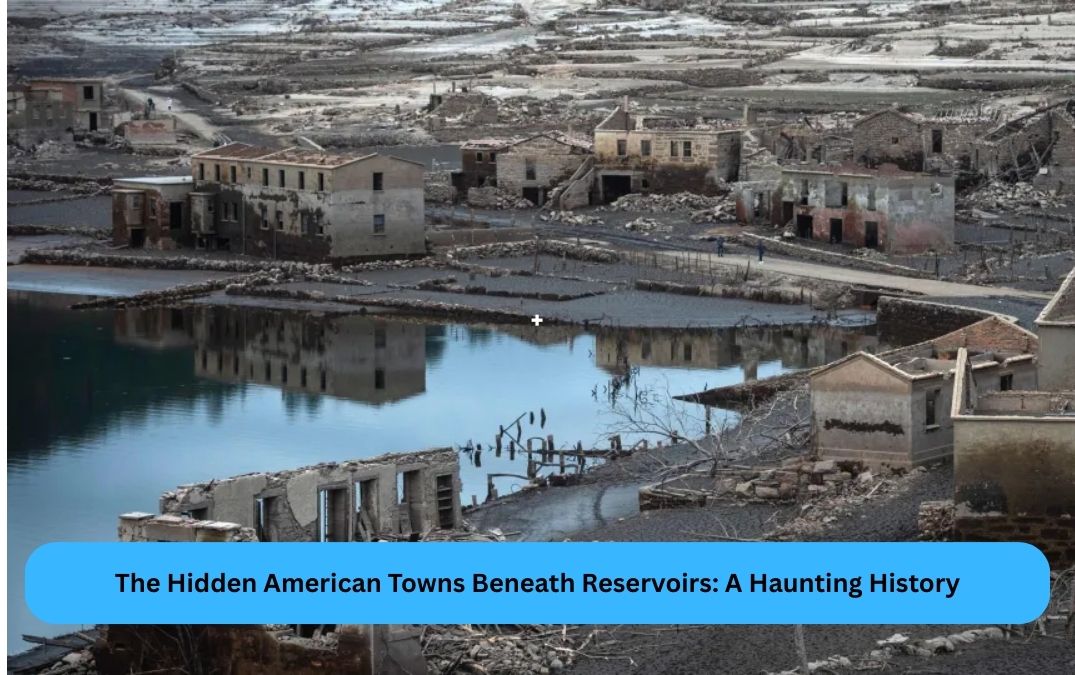Imagine walking along a serene lakeshore, the water gently lapping at your feet. Suddenly, you learn that beneath the peaceful surface lies a submerged town—streets, homes, and even a schoolhouse, all swallowed by the waters of a reservoir. The idea that entire communities were deliberately flooded to create some of the largest bodies of water in the United States is as fascinating as it is chilling. These “drowned towns” are silent witnesses to ambition, sacrifice, and a vision for the future that forever altered the landscape. What mysteries lie hidden beneath the surface, waiting to be uncovered?
The Rise of American Reservoirs: A Vision of Progress
In the 20th century, America’s rapid growth and industrial boom created an insatiable demand for water and energy. Reservoirs, which provided water storage, hydroelectric power, and flood control, became essential to meeting these needs. However, building these vast bodies of water often required an unimaginable price: the flooding of entire towns. Planners and engineers made difficult decisions, sacrificing a few communities to meet the needs of the many. The creation of these reservoirs, while viewed as a triumph of engineering, also left scars on the communities forced to leave their homes.
The Drowned Towns: A Forgotten American Tragedy
Beneath the surface of reservoirs like New York’s Ashokan, California’s Whiskeytown Lake, and Pennsylvania’s Conemaugh River Lake lie the remains of once-thriving American towns. These were not just collections of buildings; they were vibrant communities, full of traditions, hopes, and dreams for the future. As residents watched their homes disappear beneath rising water, they experienced heartbreak and disbelief. The stories of these towns are seldom shared, but for those who lived there, the sense of loss remains deeply ingrained. Sometimes, when water levels drop, traces of the past resurface—old foundations, fences, and even roads, offering a haunting reminder of life that once thrived where fish now swim.
The Engineering Behind the Flooding: A Delicate Balance
Flooding a town is no simple task. Engineers must carefully plan the process, taking into account both technical and environmental considerations. From assessing the land and calculating water volumes to constructing dams strong enough to hold millions of tons of water, each step is meticulously calculated. The process also impacts ecosystems—forests, meadows, and wildlife habitats are erased, replaced by aquatic environments. Scientists monitor these changes, tracking how plants, fish, and animals adapt to their new surroundings. This transformation is a remarkable feat of engineering, but it also comes with significant environmental consequences, forcing us to weigh progress against preservation.
The Human Cost: Stories of Loss Beneath the Waves
For those displaced by the creation of reservoirs, the experience was more than just a logistical challenge—it was an emotional upheaval. Families packed up generations of memories, bid farewell to neighbors, and watched as their familiar landmarks disappeared forever. Oral histories from these communities remind us that these towns were more than just physical places; they were homes filled with laughter, struggle, and resilience. Even decades later, the pain of displacement lingers in family stories, making the loss palpable for those who lived through it.
Exploring the Depths: Archaeology Beneath the Surface
Thanks to modern technology, divers, archaeologists, and even curious hobbyists are now able to explore the underwater remnants of these lost towns. Using sonar, underwater drones, and scuba gear, explorers map the old streets and buildings that were submerged by the floodwaters. In some cases, they uncover relics such as dinner plates, church bells, and rusted farm equipment, providing glimpses into daily life before the water rose. These explorations are both thrilling and eerie, as the silence of the deep preserves the past in an almost dreamlike state, offering valuable insights into how people lived before their world was changed forever.
Nature’s Resurgence: Life Finds a Way
Despite the destruction caused by flooding, reservoirs often become unexpected havens for wildlife. What was once a neighborhood may now be home to schools of fish swimming through sunken structures. Birds flock to new wetlands along the shoreline, and aquatic plants take root in the muddy depths. Scientists have discovered that these artificial lakes can support a variety of species, from turtles and otters to rare waterfowl. The sunken towns, now underwater reefs, offer shelter to aquatic creatures, demonstrating that while human history may be lost, nature finds a way to thrive in the changed environment.
The Economic Trade-Off: Progress at a Cost
The decision to submerge a town is never made lightly. Reservoirs provide undeniable benefits, including a steady water supply, renewable energy, recreational opportunities, and flood protection. However, the cost of creating these massive reservoirs is not just measured in dollars but also in disrupted lives and lost cultural heritage. Economists weigh the long-term advantages against the immediate sacrifices, often framing the decision as one of progress. For those whose homes and histories were erased, the trade-off can feel impossibly steep. This tension between collective gain and personal loss is at the heart of every reservoir’s creation.
A Glimpse of the Past: Resurfacing in Drought
During times of drought, water levels can drop dramatically, sometimes revealing glimpses of the sunken towns below. Exposed stone foundations, crumbling bridges, and intact road signs offer a brief but powerful reminder that the past is never truly erased. These moments draw crowds of visitors and spark renewed interest in the stories of the people who once lived in these now-submerged communities. In many ways, these events show us that history, like the water itself, is always in flux—waiting for the right moment to resurface.
Preserving the Legacy: Museums, Monuments, and Remembrance
Communities affected by reservoir projects work hard to keep their stories alive. Local museums collect artifacts and photographs, while monuments mark the original locations of lost towns. Former residents gather for reunions, sharing memories and passing them down to younger generations. Oral historians record these firsthand accounts, ensuring that the emotional and cultural impact of displacement is never forgotten. These acts of remembrance are vital in honoring the sacrifices made and ensuring that the lessons of the past continue to shape our future.
Learning from the Past: Rethinking Our Relationship with Water
As climate change and population growth place increasing pressure on water resources, the creation and expansion of reservoirs is becoming a growing concern. Policymakers, engineers, and scientists now face tough questions about how to meet our water needs without repeating the mistakes of the past. The stories of drowned towns serve as cautionary tales, urging us to consider the long-term effects of our actions. By learning from these submerged histories, we can better balance progress with compassion, ensuring a future that respects both human ambition and the environment.












